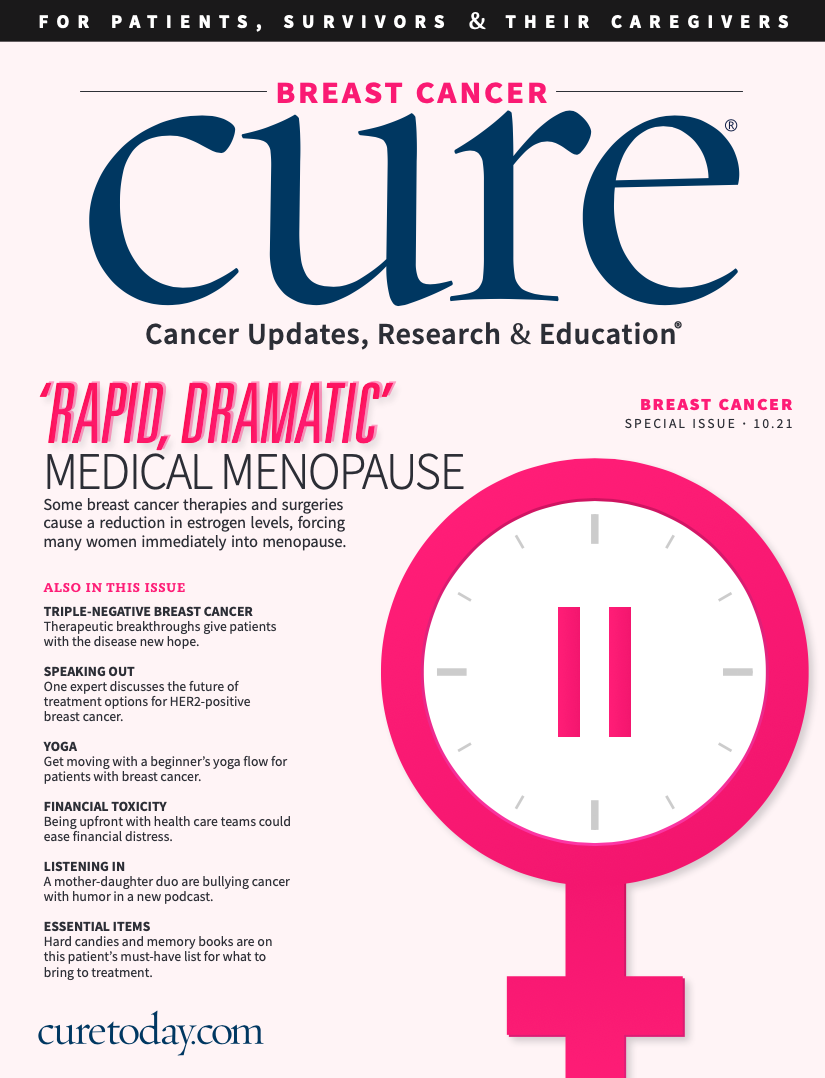Publication
Article
CURE
‘Coming Out’ to Cancer: LGBTQIA+ Discrimination in the Health Care System
Author(s):
Fear of facing discriminatory behavior within the health care system, along with other factors, may keep members of the LGBTQIA+ community from receiving cancer diagnoses.
Marie Valenzuela still recalls life around the time she received a diagnosis of stage 2B infiltrating ductal breast cancer. She was 40 years old, in a committed relationship with her girlfriend, employed at a job that she loved and diligent about her yearly health checkups. Yet she still feels the sting from a comment she believes was derived from her being a lesbian.
At the time, she had been in remission for a year after finishing treatment for breast cancer — which included a lumpectomy with axillary dissection followed by two rounds of aggressive chemotherapy, six weeks of radiation and two more rounds of chemo. After completing treatment, Valenzuela received Tamoxifen to help prevent a recurrence. Because the drug can cause abnormal growths, and rarely, cancer in the uterus, her oncologist ordered routine hysteroscopy — the insertion of a thin tube to view the lining of the uterus and take biopsies if needed — to make sure there weren’t any problems. The treatment is not often recommended in the absence of any symptoms like abnormal bleeding or changes noted on ultrasounds, which are also of low incidence in patients receiving Tamoxifen.
Marie Valenzuela with her wife Debra Gray.
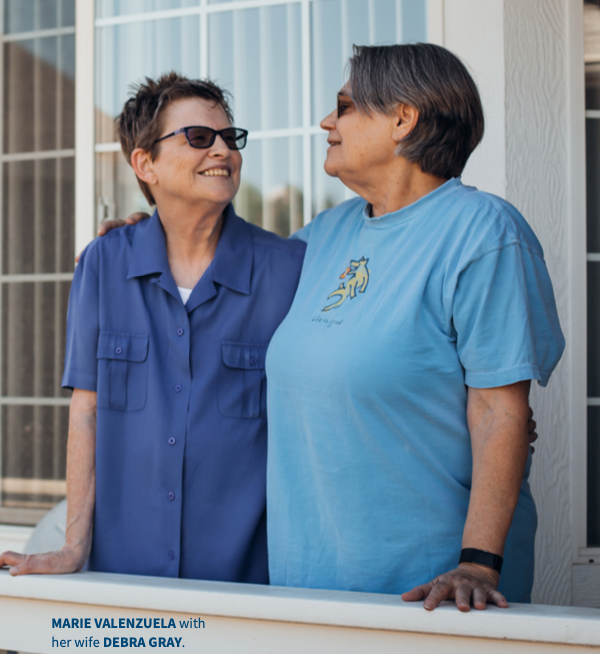
“I had to have a scoping procedure, and first thing (the doctor) did was complain about not being able to get the scope inside my uterus because I never had children. And it kind of went downhill from there,” she remembers.
While this comment could be made toward any woman who does not have children, regardless of sexual identity, those who identify within LGBTQIA+ often face harsher obstacles when it comes to starting a family, including the financial burden of fertility services, foster care or adoption.
After the doctor’s discriminatory comments, Valenzuela reported him to her health care provider.
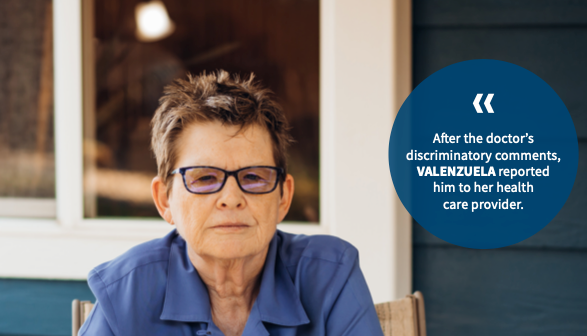
Uncomfortable and possibly discriminatory situations such as what Valenzuela experienced are what keep many LGBTQIA+ community members from seeking health care on a regular basis.
Valenzuela reported the doctor’s remarks to her health care provider immediately and requested that she see only female doctors in the future. She was determined to not let one situation keep her from getting the health care she deserved. “Barriers exist, but putting off getting your diagnosis is the last thing you want to do,” she says.
IDENTIFYING THE BARRIERS
Among other barriers, the LGBTQIA+ community has higher rates of smoking, drinking, depression and risk of obesity. These issues, along with the fear of facing discrimination, may prevent them from seeing the doctor on a regular basis, which, in turn, increases the risk of cancer or delays their receiving a cancer diagnosis and treatment.
“LGBTQIA+ individuals use tobacco products at rates 40% higher than the general population,” Michelle Veras, project director at the National LGBT Cancer Network, explains. “Why? Rejection and discrimination, the places we work and live, a legacy of targeting by the tobacco industry — these all become risk factors for diseases like cancer.”
Valenzuela was 40 years old when she received a diagnosis of breast cancer.
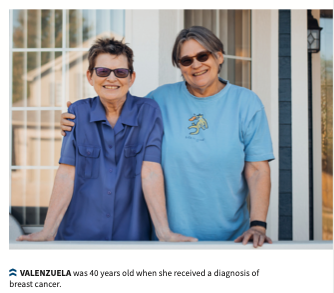
The National LGBT Cancer Network reports that insurance claims sometimes are denied if a particular test is ordered that does not align with a person’s current gender identity, affecting the transgender and gender nonconforming communities. “This not only presents logistical issues in terms of getting tests and procedures covered but it can compound feelings of being discriminated against by the health care system,” she says.
Even for some members of the LGBTQIA+ community with health insurance, gaining access to the appropriate care is difficult, Veras says. For instance, someone who is trans- gender may not be covered for any procedure or cancer screenings that are inconsistent with the gender marked on the insurance card, such as a Pap smear for a transgender man who is assigned female at birth and still has an intact cervix. “Risk factors for our communities are the result of systemic inequalities; personal choice plays such a small role in our health outcomes,” Veras says.
In addition, a primary factor that contributes to these disparities is a lack of trust in the health care system due to homophobia and transphobia, according to Dr. Jennifer Aldrich, a professor of clinical medicine at Lewis Katz School of Medicine at Temple University in Philadelphia.
“Recent surveys indicate that LGBTQIA+ people are fearful of discrimination by medical providers, causing them to seek care less frequently and be diagnosed and treated later than their straight and cisgender counterparts,” she explains.
Health care professionals need training to become inclusive, Aldrich emphasizes.
Dr. Anosheh Afghahi, a medical oncologist at the University of Colorado Cancer Center in Aurora, adds that transexuals on estrogen supplementation also face an increased risk of breast cancer and other hormone-driven cancers. At greatest risk are individuals with a strong family history of breast cancer or who have inherited a genetic mutation such as BRCA1 or BRCA2.
FINDING SUPPORT
Catherine Sumner, who is a lesbian, survived thyroid cancer in 2003. She had no known history of breast cancer, and she says she was good about getting medical checkups, especially after receiving her diagnosis of thyroid cancer.
In 2010, Sumner found herself in the doctor’s office for a cortisone shot after she believed she had pulled a muscle training for a triathlon. “I was feeling great, and I would run one to three miles a day,” she says. “I went in for a checkup when I found a lump above my breast while I was rubbing in Tiger Balm after pulling a muscle. ... So I went to my primary (care) doctor.”
The nurse practitioner was preparing the cortisone shot when she realized that it could be more than just a pulled muscle. After a same-day appointment to examine the lump with an oncology surgeon, she was diagnosed with breast cancer. “And it blew me out of the water at age 31,” Sumner says.
That was in March. By April 1, she had started a treatment of chemotherapy plus Herceptin (trastuzumab). By September 9, she had had a lumpectomy with clear margins. Her cancer diagnosis changed from stage 3 to a “smaller” stage 2, and she began two months of daily radiation, then continued the Herceptin. Sumner was lucky enough to have providers who were thoughtful with her treatment and care at Virginia Hospital Center in Arlington.
“Too often, doctors don’t work with patients in the gay community, and if that collaboration isn’t there, having someone talk at you and not with you — it doesn’t work,” Sumner explains. “My oncology team, even though I’m gay, (they) asked things like, ‘Don’t you want to freeze your eggs?’ I’m like, ‘With this? No way.’ But (my oncologist) told me that maybe I would want them someday.”
Catherine Sumner.
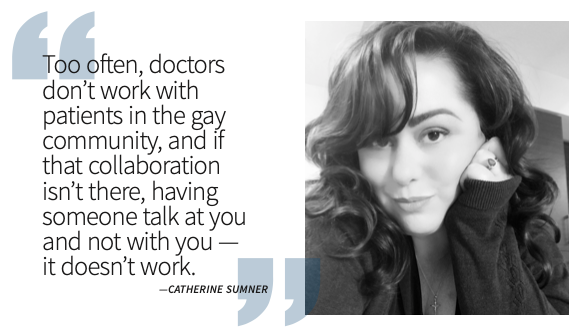
Sumner adds, “(My oncologist) was very aware of my fertility and treated me like a woman, not ‘Oh, she’s gay and she’s not going to get pregnant.’”
Sumner says she still struggled to find an inclusive support group where she could feel comfortable. The first group she attended consisted mainly of heterosexual women, and although Sumner says she was sure they were nice, she wasn’t able to relate as closely with their experiences. “I learned that it is very difficult to be the only lesbian in a breast cancer support group. I didn’t feel comfortable coming out to a group of older straight women. I had trouble relating to them and generally felt very out of place, so I didn’t go back after the first visit,” Sumner explains.
Instead, she relied on friends, family and her priest for support, and often she brought a friend with her to appointments, as well.
“It’s wise to bring someone with you and look for a doctor you feel comfortable with,” she adds. “The last thing you want to do is let fear take hold of you and you don’t go to your appointment, or you feel like you don’t have someone to talk to who understands you.”
BREAKING DOWN BARRIERS
When it comes to breaking down the barriers — such as those experienced by Valenzuela and Sumner — in health care for the LGBTQIA+ community, Afghahi believes medical professionals haven’t done enough to eliminate disparities.
“The medical community also has been slow to incorporate specific learning opportunities for providers and students so they can learn about specific issues surrounding the health of LGBTQIA+ individuals. That’s another reason why disparities persist,” she says.
Approximately 30% of LGBTQIA+ adults don’t seek health care services or have a primary health care provider, compared with 10% of heterosexuals, according to study results presented at the 2020 American Society of Clinical Oncology Quality Care Symposium. In the study, researchers partnered with the LGBT Community Center of Greater Cleveland, Plexus LGBT & Allied Chamber of Commerce and TransOhio to create programming, including a mammogram clinic for sexual/gender minority women, a “Cancer is a DRAG” show and a tobacco-free campaign. The result? More than 150 people were educated about these disparities and more than 85 were screened within the first year, proving that creating meaningful partnerships between health care and LGBTQIA+ communities, as well as programming patients can relate to, may help decrease health disparities in that subset.
It is educational programs and outreach such as this that Afghahi thinks could jump start the conversation and recognition of what needs to be changed in the health care system to be inclusive of all. She says, “Engaging in a two-way conversation to allow the patients to teach providers about their concerns is a way to start the conversation. I think it always starts with educating providers on the health issues that matter for this patient population, engaging in discussion with each other and having an open mind.”
Aldrich adds another important element needed to break down barriers: educating those within the health care field so that inclusivity starts at the beginning of a patient’s journey within a cancer center or hospital.
“It is important to collect sexual orientation and gender identity when we first meet a patient,” she emphasizes. “Open communication will help providers address potential concerns about treatment effects on sexual activity, body image and relationships, and will allow the team to include the important people in the patients’ care.”
Increasing education and information about patients in this subset could build a stronger patient-provider bond, allowing for more compassionate conversation and mindfulness. “Traditionally, the medical establishment has been heteronormative (the belief that heterosexuality is the normal mode of sexual orientation), and LGBTQ+ patients often have not disclosed their orientation or gender identities to their providers. We, as medical professionals, must ask the appropriate questions and allow patients to feel safe in disclosing to us, so that we can together build a trusting, nondiscriminatory relationship,” Aldrich adds.
Dr. Mitchell Lunn, an assistant professor in the Division of Nephrology of the Department of Medicine at Stanford University School of Medicine in California, agrees as both a provider and as someone who identifies as a gay man.
Lunn says the health care community needs to be better trained to “not make assumptions about people and their personal experiences including partners or sex life.”
He says understanding the LGBTQIA+ community means “training (providers) to ask patients about the name they use, as well as which pronouns they use, and understanding that a partner may want to accompany the patient during procedures.”
The bottom line, Lunn concludes: “It is important for all providers to be welcoming and affirming to LGBTQIA+ people.”
For more news on cancer updates, research and education, don’t forget to subscribe to CURE®’s newsletters here.
